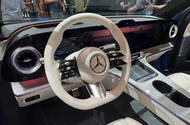Why Are Physical Buttons Making a Comeback in Mercedes Cars?
If you’ve stepped inside a modern car lately, you’ve probably noticed the trend: fewer buttons, more screens. For a while, it seemed like every new vehicle was racing toward a future where everything—climate, music, even opening the glovebox—was controlled by a touchscreen. But Mercedes-Benz, a brand known for its cutting-edge tech, is changing course. Why? Because the data says so.
Magnus Östberg, Mercedes’ software chief, recently shared that real-world usage data shows drivers actually prefer physical buttons for certain functions. It’s not just nostalgia talking—there’s solid evidence that tactile controls are easier and safer to use, especially while driving. This insight is shaping the next generation of Mercedes interiors, starting with the new GLC and CLA Shooting Brake EVs, both of which feature a redesigned steering wheel packed with rockers, rollers, and good old-fashioned buttons.
What’s Driving the Shift Back to Physical Controls?
So, what’s behind this pivot? It turns out, not all drivers are thrilled about having to tap through menus just to adjust the volume or change the radio station. Mercedes’ data, gathered from their new software-defined vehicles (SDVs) like the CLA and GLC, reveals that high-frequency tasks—think adjusting temperature or skipping a song—are simply faster and less distracting with physical controls.
This isn’t just a hunch. A 2023 study by the Swedish car magazine Vi Bilägare found that drivers took significantly longer to perform basic tasks on touchscreens compared to traditional buttons, sometimes with their eyes off the road for dangerously long periods. Mercedes is taking these findings seriously, aiming to strike a better balance between digital and tactile interfaces.
How Will This Change the Mercedes Driving Experience?
The new steering wheel design, loaded with physical controls, will become standard across the Mercedes lineup. Even models already on sale will get the upgrade, starting with the latest CLA saloon. This approach is both cost-effective and user-friendly, letting Mercedes enhance existing cars without a complete interior overhaul.
But it’s not just about the steering wheel. Mercedes is considering adding more physical buttons throughout the cabin, especially in larger vehicles like SUVs. The reasoning? Bigger cars offer more space for extra controls, and their buyers tend to value tactile feedback even more.
Are Touchscreens Going Away Completely?
Not at all. In fact, Mercedes is pushing the boundaries of digital displays with its new MBUX Hyperscreen—a jaw-dropping 39.1-inch panel that stretches across the entire dashboard of the GLC. It’s likely the largest screen ever fitted to a production car. But even as screens get bigger and more impressive, Mercedes designers like Gordon Wagener acknowledge there’s a practical limit. “We have reached a point where you cannot make the screen much bigger,” he said at the Munich Motor Show.
Instead, the focus is shifting to making these digital experiences feel more luxurious and intuitive. That means refining the software, improving voice controls, and ensuring that the technology enhances rather than overwhelms the driving experience.
How Does Mercedes Tailor Tech for Different Markets?
One fascinating insight from Mercedes’ data-driven approach is that preferences vary by region. While European drivers tend to favor physical buttons, drivers in Asia—especially China—are more comfortable with touchscreens and advanced voice controls. Mercedes is responding by considering different steering wheel and control layouts for different markets, ensuring that each customer gets the experience they want.
Voice commands are also on the rise, with usage among Mercedes drivers reportedly tripling in recent years. This is particularly important in China, where seamless voice interaction is a must-have feature.
What Does This Mean for the Future of Car Interiors?
Mercedes’ move to reintroduce physical buttons isn’t just a nod to the past—it’s a sign of a more thoughtful, user-centered approach to car design. As vehicles become more software-driven, automakers have access to unprecedented data about how drivers actually use their cars. That means future interiors can be shaped by real-world needs, not just design trends.
Expect to see a blend of tactile and digital controls, tailored for different markets and vehicle types. And as artificial intelligence and voice recognition continue to improve, the line between physical and digital will blur even further.
The Takeaway: It’s All About Balance
At the end of the day, Mercedes’ decision to bring back physical buttons is about making life easier—and safer—for drivers. It’s a reminder that sometimes, the simplest solutions are the best. As technology continues to evolve, the brands that listen to their customers and adapt accordingly will be the ones that stand out. For Mercedes, that means embracing both the future and the familiar, all in the name of a better driving experience.

